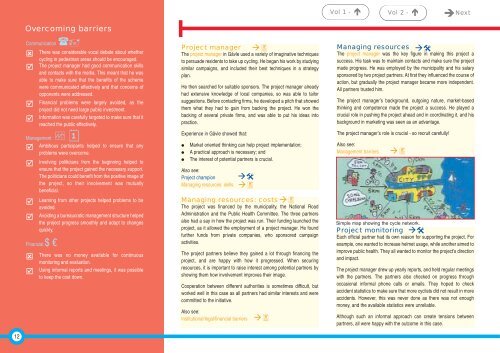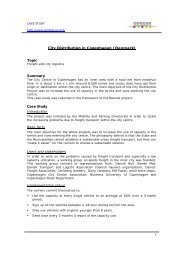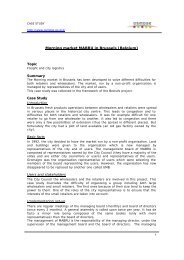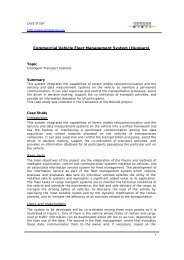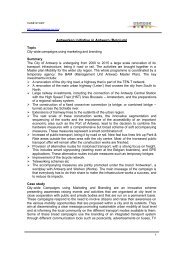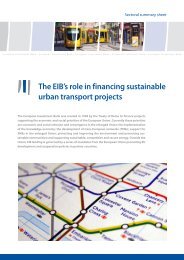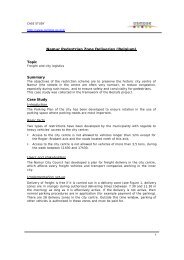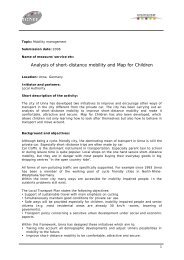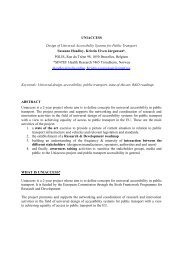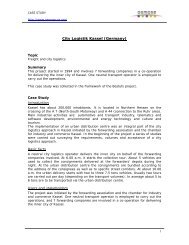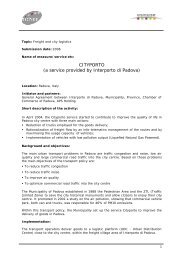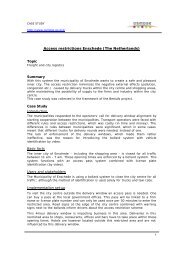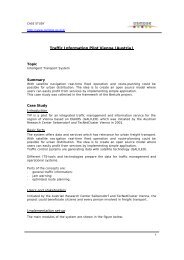Successful transport decision-making - Osmose
Successful transport decision-making - Osmose
Successful transport decision-making - Osmose
You also want an ePaper? Increase the reach of your titles
YUMPU automatically turns print PDFs into web optimized ePapers that Google loves.
Overcoming barriers<br />
Communication <br />
<br />
There was considerable vocal debate about whether<br />
cycling in pedestrian areas should be encouraged.<br />
<br />
The project manager had good communication skills<br />
and contacts with the media. This meant that he was<br />
able to make sure that the benefits of the scheme<br />
were communicated effectively and that concerns of<br />
opponents were addressed.<br />
<br />
Financial problems were largely avoided, as the<br />
project did not need large public investment.<br />
<br />
Information was carefully targeted to make sure that it<br />
reached the public effectively.<br />
Management <br />
<br />
Ambitious participants helped to ensure that any<br />
problems were overcome.<br />
<br />
Involving politicians from the beginning helped to<br />
ensure that the project gained the necessary support.<br />
The politicians could benefit from the positive image of<br />
the project, so their involvement was mutually<br />
beneficial.<br />
<br />
<br />
Learning from other projects helped problems to be<br />
avoided.<br />
Avoiding a bureaucratic management structure helped<br />
the project progress smoothly and adapt to changes<br />
quickly.<br />
Financial $ €<br />
<br />
<br />
There was no money available for continuous<br />
monitoring and evaluation.<br />
Using informal reports and meetings, it was possible<br />
to keep the cost down.<br />
Project manager<br />
The project manager in Gävle used a variety of imaginative techniques<br />
to persuade residents to take up cycling. He began his work by studying<br />
similar campaigns, and included their best techniques in a strategy<br />
plan.<br />
He then searched for suitable sponsors. The project manager already<br />
had extensive knowledge of local companies, so was able to tailor<br />
suggestions. Before contacting firms, he developed a pitch that showed<br />
them what they had to gain from backing the project. He won the<br />
backing of several private firms, and was able to put his ideas into<br />
practice.<br />
Experience in Gävle showed that:<br />
<br />
<br />
<br />
Market oriented thinking can help project implementation;<br />
A practical approach is necessary; and<br />
The interest of potential partners is crucial.<br />
Also see:<br />
Project champion<br />
Managing resources: skills<br />
<br />
<br />
Managing resources: costs<br />
The project was financed by the municipality, the National Road<br />
Administration and the Public Health Committee. The three partners<br />
also had a say in how the project was run. Their funding launched the<br />
project, as it allowed the employment of a project manager. He found<br />
further funds from private companies, who sponsored campaign<br />
activities.<br />
The project partners believe they gained a lot through financing the<br />
project, and are happy with how it progressed. When securing<br />
resources, it is important to raise interest among potential partners by<br />
showing them how involvement improves their image.<br />
Cooperation between different authorities is sometimes difficult, but<br />
worked well in this case as all partners had similar interests and were<br />
committed to the initiative.<br />
Also see:<br />
Institutional/legal/financial barriers<br />
<br />
<br />
<br />
Vol 1 - <br />
Managing resources<br />
The project manager was the key figure in <strong>making</strong> this project a<br />
success. His task was to maintain contacts and make sure the project<br />
made progress. He was employed by the municipality and his salary<br />
sponsored by two project partners. At first they influenced the course of<br />
action, but gradually the project manager became more independent.<br />
All partners trusted him.<br />
The project manager’s background, outgoing nature, market-based<br />
thinking and competence made the project a success. He played a<br />
crucial role in pushing the project ahead and in coordinating it, and his<br />
background in marketing was seen as an advantage.<br />
The project manager’s role is crucial - so recruit carefully!<br />
Also see:<br />
Management barriers<br />
Vol 2 - <br />
<br />
Simple map showing the cycle network.<br />
<br />
<br />
Next<br />
Project monitoring<br />
Each official partner had its own reason for supporting the project. For<br />
example, one wanted to increase helmet usage, while another aimed to<br />
improve public health. They all wanted to monitor the project’s direction<br />
and impact.<br />
The project manager drew up yearly reports, and held regular meetings<br />
with the partners. The partners also checked on progress through<br />
occasional informal phone calls or emails. They hoped to check<br />
accident statistics to make sure that more cyclists did not result in more<br />
accidents. However, this was never done as there was not enough<br />
money, and the available statistics were unreliable.<br />
Although such an informal approach can create tensions between<br />
partners, all were happy with the outcome in this case.<br />
12


